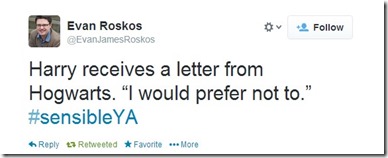There was a great hashtag going on Twitter yesterday.
Granted, my reply was brief and a little snarky (“Then we would have no plots”) as were most of the direct replies to the tweet, but a lot of other users ran with it and made it hilarious.
Of course, as tends to happen with me, the jokes got me thinking. The truth is that most YA fiction is, in fact, driven by kids who make stupid decisions. In adult fiction, a book that was driven by a protagonist who made one stupid decision after another would send readers screaming and demanding their money back (although there are some notable exceptions) but in YA it’s not only acceptable, it’s almost expected.
Why is this so?
I think the main reason is that kids like protagonists that they can identify with. The heroes and heroines of YA need to “feel real” for kids to connect with them. Young protagonists have to sound, think, and act like actual teenagers if they’re going to click with a teen reader.
Occasionally you can get away with having a protagonist who is forced by circumstance to grow up early (due to a hard life, out on the streets or in a dystopian world) but for the most part YA protagonists have to act like the teenagers we claim they are, and that means they do stupid things.
Some basic facts to consider when plotting a YA book:
Kids are impetuous and reckless
Kids think with their hearts and jump into action. Where an adult might take a second to reason out all (or at least a few) of the consequences of an action, kids jump in head first.
Consider The Hunger Games. The initiating action that starts the whole story is Katniss’ volunteering to be tribute instead of her little sister Prim. If you sit back and think about it, this is a very stupid decision.
Katniss is the provider for her family. She knows how to hunt, she knows how to bargain, and she has essentially been the mother of the family since her father has died and her own mother went into shock. With her gone (which would send her mother into another downward spiral and make her useless again), Prim would have no one to care for her. Plus, Prim would be totally incapable of taking care of her mother and as a result both of them would be doomed. Prim would be doomed anyway. The logical, adult thing to do would be for Katniss to try to pull the pieces together and take care of her mother with her sister gone.
Katniss does not think logically; she thinks with her heart. She can’t stand the thought of Prim dying in the Games (although her demise and suffering without the Games would still be all but certain and much more prolonged) so she steps up.
This is not the logical move. But it is the right one. That is why Katniss is a hero. And why The Hunger Games is a classic.
Kids are inexperienced
The main reason that kids are so impetuous and reckless is simply because they haven’t learned as much as adults. They haven’t experienced enough to make reasoned, logical decisions in all cases.
Consider Paper Towns by John Green. Q is so taken by Margo’s impetuous actions that when she disappears he becomes convinced that she wants him to find her. He assumes that everything he sees is a clue meant to lead him on to find her.
Experience would tell Q that most people who run away don’t want to be found. They mean to leave their previous life behind in its entirety. He might also come to realize that what he loves about Margo is her mystery, not the girl herself.
So much frustration, exhaustion, and really stupid decisions could have been avoided if Q had just been a little more familiar with life. But he isn’t, so he chases after the mystery girl. And as a result, Paper Towns is a compelling story.
Kids learn by doing
Not to demean our educational system, but the way kids’ brains are wired means that they learn much more easily from doing things than from being shown or told things. This is why we give blocks and similar toys to kids: so they can figure out some of the basics of how things work. Things fall down. Check. Wide bases are best for building tall structures. Check. You can’t fit a big thing into a small hole. Check. Different objects have different shapes, check.
As kids get older, the lessons they learn are much more complex than the basic lessons of babies and toddlers, but their brains are still wired to learn through experimentation and action. They don’t know whether something will work until they try it.
Thus it’s easy for a kid to get a harebrained idea into his head and try to see if it will work or not. Of course, if the kid were to do some research into the idea the feasibility could easily be established, but that takes too long and gets too boring. Faster and easier to just try it and see what happens. That also makes for better reading.
Conclusion
The trick to creating realistic YA is to have your protagonists think and act like actual teenagers. Teens are rash, reckless, inexperienced, and often do the wrong thing. But they learn from doing it. You cannot have your protagonists be sensible (although a Voice of Reason supporting character can be handy to have from time to time); not only is it bad drama, it’s not how the world is.






Be First to Comment